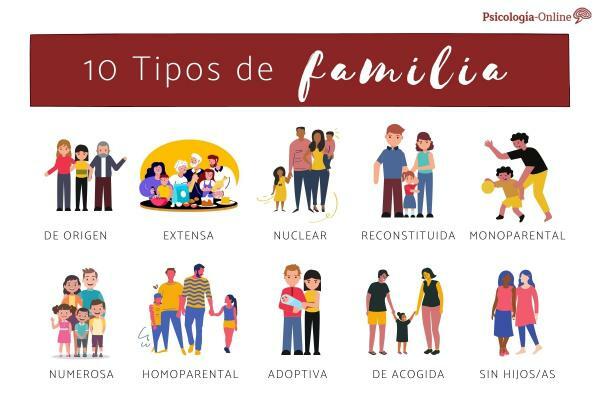
In sociology, family types is something that has been studied over the years. The definition of family according to authors varies, since it is a complex concept. According to Émile Durkheim, the family structure is united by the fact of sharing values. For Herbert Spencer, the functions of the family are procreation and ensuring the minimum conditions for the existence of children.
Families have evolved over the years. What are the types of family that exist in today's society? Single-parent families, homoparental families, among others, are becoming more and more common. So that, today, we find a great variety of types of families. If you want to know some of these current family types and their characteristics, do not hesitate to continue reading this Psychology-Online article where we will expose the 10 types of family that exist in today's society and their characteristics. Do you identify with any of them?
Index
- Family of origin
- Extended family
- Nuclear family
- Reconstituted family
- Single parent family
- Large family
- Homoparental family
- Adoptive family
- Host family
- Family without children
1. Family of origin.
The family of origin refers to the typical family where there is a single union between two adults and a single line of descent, that is, the closest family: parents (progenitors) and their children. This type of family is made up of the following subsystems: conjugal, paternal, children and siblings. Thus, it is a parent couple that generates new individuals, raises them and educates them in a family environment.
In this sense, origin is an aspect that defines people, that is, the origin of people is what, to a large extent, today makes them who they are. What's more, origin is of great importance in development of people, since it can influence when developing genetic diseases or when facing complex situations through difficult emotional responses. For this reason it is important to attend to the family dynamics, to be able to observe if affect, dysfunctional dynamics predominate, among others.

2. Extended family.
When we speak of the extended family we refer to that family made up of all their consanguinity members that go beyond the nucleus that coexists in the same home, that is, whose relationships are not unique and exclusively between parents and children, but include other relatives of consanguinity or related. For example, some of the members considered as extended family are cousins, uncles, grandparents, etc.

3. Nuclear family.
This type of family refers to those family members who they live in the same family nucleus, that is, in the same home. Normally these are the same components as in the family of origin (mother, father and children), although on some occasions they can be add other members, such as those families in which they cohabit with other members of consanguinity, such as, for example, grandparents. There are different types of nuclear family such as simple nuclear family, biparental nuclear family, single parent nuclear family, extended nuclear family, etc.
In order to get a clear idea of what a person's nuclear family is, a genogram can be performed. The genogram is a diagram or graphic representation where information is noted about the members of the family, at least three generations, and the relationships they have between them. Thus, within the genogram, in order to know which is the nuclear family, with a pencil they are surrounded, leaving within a circle, to family members who live together within the same household.

4. Reconstituted family.
Another type of family that exists in today's society is the reconstituted family. The reconstituted family is characterized by introduction of a new marital relationship in the family, with the existence or not of children of previous couples or conjugal relationships. Thus, these are families formed or reconstituted by members outside the family, who usually come from other family nuclei.
For example, in a family of divorced parents, one of the parents begins a new marital relationship with another person. This situation implies that the children must adapt to the arrival of their parent's new partner, especially if this new partner moves into the home.

5. Single parent family.
Another type of family that exists is the single parent family. Single-parent families are those that are formed by one of the parents (mother or father) and her children. These situations can be caused by different aspects: separation or divorce of the parents, where only one parent takes care of the children; being a single mother without knowing the father (artificial insemination, adoption, unwanted pregnancy ...); death of one of the parents; and finally, the abandonment of one of the parents. There are different types of single parent families.
Depending on each situation, some consequences or others may be generated in the children (emotional deprivation…), generally minors and, therefore, more vulnerable than adults. In addition, single parenthood can cause an overload for the parent who takes care of the children, due to the absence of the figure of the other parent. In this article you can read tips for single parents.

6. Large family.
Large families are those in which the parents have three or more children, being the number that limits it determined by each country. In addition, it should be noted that there are two degrees of large family that are differentiated by the number of children and other circumstances such as single parenthood, the disability of one of the children, among others.
In Spain, these two degrees are called general large family and special large family. In addition, the fact of being a large family is related to benefits and social assistance that the family receives for the fact of being numerous and, depending on each grade and specific situations, the benefits will be some u others. Large family requirements change by area and change over time.

7. Homoparental family.
The homoparental family, as its name indicates, refers to those families in which the parents are homosexual, that is, parents share the same sexEither two men or two women. When these couples choose to have children, they usually resort to adoption or artificial insemination.
Formerly, this type of family was less seen, since socially they were frowned upon in compared to classic heterosexual families and therefore had a more difficult time qualifying for adoption. But as the years have passed, these families have become more and more accepted and tolerated. The homoparental family is another of the types of families that exist in today's society.

8. Adoptive family.
Another type of family is the adoptive one. The adoptive family refers to those parents who decide to adopt a child. Even if they are not their biological parents, they must play the role or parent role, so that they will be the ones who will educate their adopted children and will carry out all those tasks that all biological parents usually perform.
The meaning of child adoption is to receive a boy or girl as a child without having gone through the biological process of conception. There are different types of adoption, such as domestic adoption and international adoption.
Adopting implies a mutual benefit between the adoptive parents and the children. On the one hand, children are given the opportunity to have a family, since they were previously abandoned by their biological parents, a fact that can generate great traumatic consequences depending on the situation. On the other hand, adoptive parents are benefited since they can fulfill their desire to be fathers or mothers and that for different reasons they cannot be biologically so, although there are many people who decide to adopt in order to meet the needs of the children who need it most.

9. Host family.
On many occasions, foster families are confused with adoptive families. Although it is true, in both types of family the adults who take care of the children are not their parents However, what differentiates them is the amount of time the child will spend with these non-parents. biological.
In the case of adoption, It is a permanent situation of the child in the adoptive family, that is, the child immediately becomes the child of her adoptive parents. On the other hand, in the case of reception, it is a temporary foster care of children in a family other than their own, due to the need to separate from their biological parents as estimated by social services, and thus be able to to offer them an environment where children have the possibility to grow apart from their parents' family problems, until they have solved their problems.

10. Family without children.
A couple who live together, who have a common life project and who love and support each other, can be another of the current types of family. Also without children, an adult couple can form a family. The couple can be both heterosexual and homosexual.

This article is merely informative, in Psychology-Online we do not have the power to make a diagnosis or recommend a treatment. We invite you to go to a psychologist to treat your particular case.
If you want to read more articles similar to The types of families that exist and their characteristics, we recommend that you enter our category of Social psychology.
Bibliography
- Cadoret, A. (2004). Pluriparent and reference family. Adoption and foster care. Present and perspectives. Barcelona: University of Barcelona, 273-283.
- Caniço, H., Bairrada, P., Rodríguez, E., and Carvalho, A. (2010). New types of family: care plan. University of Coimbra: coordinaçãor.
- Pillcorema Ludizaca, B. AND. (2013). Types of structural family and the relationship with their limits (Bachelor's thesis).


